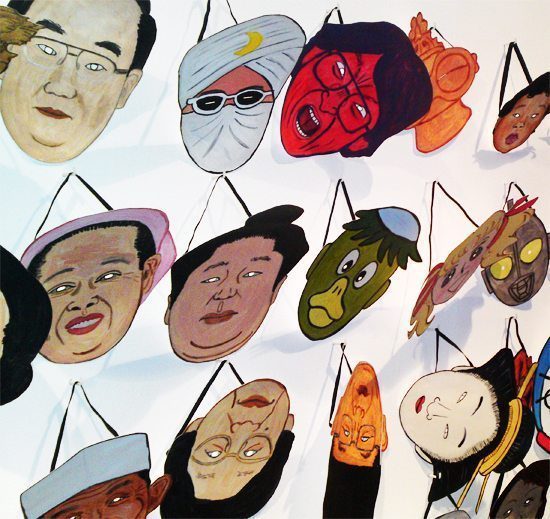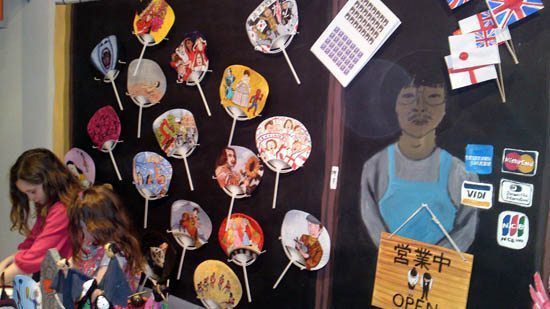Attack of the Stereotypes
In a dark, dark town there was a dark, dark street,
And on the dark, dark street there was a dark, dark building
And in the dark, dark building were…
BRIGHT JAPANESE THINGS!
This was the feeling I got when walking into 'Tokyo', a large themed exhibition of painting, installation and sculpture spanning two floors of the Flowers gallery on Kingsland road. One is immediately bombarded with images of yellow-skinned Japanese caricatures (occasionally with lines for eyes) going about their larger-than-life days in a multicoloured metropolis. Incorporating every kind of face, from anime to politicians, the anachronistic oil-painted faces that grin from paper masks and jape from free standing cut-out manifest a sense of cultural caricature as extreme as that of Herge. This begs the question whether the viewer is an accomplice, an audience or the target of the exhibition. Who are the faces laughing at?

(Warning: this article contains instances of inverted commas to indicate common words as high concept and ontological discourse)
Had a Westerner done this, even 'ironically', there would have been a riot. But relax people, the artist is Japanese. Which means this exhibition is not racist, despite Osuga having lived in the UK for over 30 years and only making these works after re-visting Tokyo. No, knowing that the artist is part of the culture depicted, however tenuously, removes most of the tenseness that accompanies complicity. The clichés can be appreciated as jokes, and so the power of the exhibition is revealed. Tokyo is neither celebrated nor ridiculed here, but explored.
The focus on what we think of as singularly Japanese gestures and situations, seen in the paintings Irrashaimase! (bowing, 2010), or Ramen Bar (eating at a bar, 2010), highlights the audience's awareness of their own movements in this confusingly transformed western gallery space. A kind of disjointed map of movement is presented, with instillation pieces inviting interaction and paintings depicting the kinds of behaviours to therefore adopt.This ‘other’ culture, with its bright colours and smiling faces, emphasises that Art spaces can use structure to enforce a singular type of comprehension. Being purposely disorientating Osuga, an artist, forces the question ‘how should we act’?.

Children show us the way by running to play with objects at Sweet Stall (2010). Little signs in Japanese and English encourage us to interact; 'you may sit here', 'please remove shoes before walking on painting'. It has to be said that actually walking on a painting, however used to contemporary interactive art we think we are, feels surprisingly transgressive and therefore joyfully liberating.
By the time we reach the second level of the gallery we are old masters of the method, unselfconsciously reaching out to open the advent calendar windows of the Cherry Blossom series (2010). Pieces such as Vending Machine (2010) which predictably depicts a vending machine with bottles inscribed with artists' names (Picasso, Carvaggio etc.) poke fun at traditional Western gallery presentation and East-West fetishisation.
The titles were what truly conveyed the sense of almost-understanding outsider, close to what one believes the artist must have felt. Each of us wandered around clutching a titled price list like a guidebook, trying to match prices with untitled pieces. Some were easy to identify, for example Stepping Stones (2010) lay on the ground waiting for us to hop on. However, when setting ourselves a mission to locate The Sound of One Hand Clapping (2010) a friend looked around for a bit and pointed at a suspended papier mache aeroplane and said 'that one'. Frankly, it may well have been. The point is, like a tourist we don't know the intimate meanings of every aspect of the culture presented. We can look at it, paint it, sit, stand on it, be part of it, but eventually we have to give up on taxonomic representation from our own perspective and just go with it. In this way, Osuga has done something clever; he has shocked us, soothed us, confused us and most importantly he has entertained us. But for all the sensual delights of his show, I wonder whether he hasn’t educated us as well through showing us that the institutionally-approved experience of standard art viewing is a form of lazy habit, as well as demonstrating that our ideas of what is controversial are located in a set of visual standards that perhaps need to be re-assessed.

We come away smiling at having had an unusual gallery experience (standing on art felt hilariously rebellious), yet something niggles. In the end, by being free to laugh at these stereotypical depictions I wonder whether we’re accepting the stereotypes, as it was indeterminate whether the focus was either ‘Haha racism, that’s so funny’ or ‘those exaggerated features are hilarious’. Because we knew the artist was Japanese, it was acceptable. That we know this was an artist who has spent most of their life in our culture means that we question whether his depictions are more ‘us’ or ‘them’. Would we have accepted it from anyone else? Does the fact that we worry about this at all mean we are too paranoid about political correctness or that we are too accepting of the controversial? Can a stereotype ever be beautiful art?
All cultures are possible in Osuga’s kaleidoscopic paper mirror and as such it’s confusing place. Is this just an exhibition that courts racial sensationalism or does it attempt to unpack the signs and signifiers of stereotypes through installation? I’m still not sure but I wish all racial discourse was as fun as this.
Jiro Osuga's 'Tokyo' at Flowers Gallery
25th Feb- 26th March 2011

The aim of art is to represent not the outward appearance of things, but their inward significance. – Aristotle















